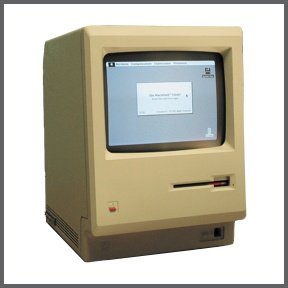HOW APPLE
DEPOSITIONED IBM
How Apple® De-Positioned The IBM PC and Won The Early PC Wars
Everyone knows that IBM virtually invented the category of Personal Computers (PCs). While there were kit computers before then, none took hold in the market. IBM’s 5150 was the first truly personal computing system. And it worked fine (given the technology capabilities of the day). Even at a huge price tag, it was an enormous success, virtually selling out upon its announcement. From a computing standpoint, it had everything a small computer could have for its time.
The PC Wars Back-Story
By introducing the 5150 (the “IBM PC” as it was called), IBM literally invented the category of PCs in the public mind.
But the IBM PC had several drawbacks that would be its undoing. It was very heavy (over 30 pounds with all its components).
It required at least 3 separate components (computer, screen and keyboard), all of which required a tangle of wires to connect to each other. You could not easily move it from one place to another. And this was the opportunity that enabled Apple to become the giant it is today… all based on positioning… and more specifically on DE-POSITIONING to be DISRUPTIVE in the minds of IBM PC users.

IBM MODEL 5150 – FIRST IBM PC – 1981
While it had been in existence since 1977, Apple Computers (as it was called back then) had been working on developing a computer operating system that would outclass the IBM operating system by miles – better graphic interface, faster performance, color screen capabilities, and more software applications.
But NONE of these functional aspects became the positioning that helped Apple win the early PC wars.
The first breakthrough personal computer that catapulted Apple to stardom was the Macintosh, introduced in 1984 – 3 full years after IBM staked claim to the PC positioning.
The Macintosh did NOT attempt to market itself as the “better mousetrap” (or the ‘better PC’); that would not have worked. They used positioning science to create an entirely new ‘Category Class’ (and DE-POSITION the IBM PC): while IBM owned the Personal Computer niche, Apple created and claimed the class positioning of the PORTABLE Personal Computer; it had integrated the screen and the computer into a single unit, weighing less, required less wiring, and being capable of actually being taken home on the weekend.

APPLE MACINTOSH 1984
PORTABILITY was not, back then, a necessary functional requirement of a PC; it was an ASPIRATIONAL element of consumer convenience that the competition did not provide – it did not have to compete against IBM for the PC market, it created and thus owned its own unique new ‘Category Class’ – and who wouldn’t want to bring their computer home on the weekend? It even had a plastic cover and a handle on top.
Again, the strategy of creating a new category that fulfilled consumers’ ASPIRATIONAL desires for the product while DE-POSITIONING the competitor made it a winner, without having to compete financially against an entrenched giant.
